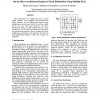Free Online Productivity Tools
i2Speak
i2Symbol
i2OCR
iTex2Img
iWeb2Print
iWeb2Shot
i2Type
iPdf2Split
iPdf2Merge
i2Bopomofo
i2Arabic
i2Style
i2Image
i2PDF
iLatex2Rtf
Sci2ools
ICCD
2001
IEEE
2001
IEEE
On The Micro-architectural Impact of Clock Distribution Using Multiple PLLs
Clock distribution has traditionally been a circuit design problem with negligible micro-architectural impact. However, for clock distribution networks using multiple phase-locked loops (PLLs), this will most likely not be the case. This paper discusses the microarchitectural impact of using multiple PLLs for clock distribution. Two PLL phase synchronization algorithms are presented and analyzed. They are compared in terms of efficiency, performance, and complexity. For both, the micro-architectural impact is small, but certainly not negligible.
Clock Distribution | Clock Distribution Networks | Hardware | ICCD 2001 | Negligible Micro-architectural Impact |
Related Content
| Added | 16 Mar 2010 |
| Updated | 16 Mar 2010 |
| Type | Conference |
| Year | 2001 |
| Where | ICCD |
| Authors | Martin Saint-Laurent, Madhavan Swaminathan, James D. Meindl |
Comments (0)

